Logistics
Industries
Technology & Innovations
E-commerce
E-commerce Fulfillment Services
Lease & Maintenance
Semi Trucks
Logistics
E-commerce
Lease & Maintenance
Buy Used Trucks
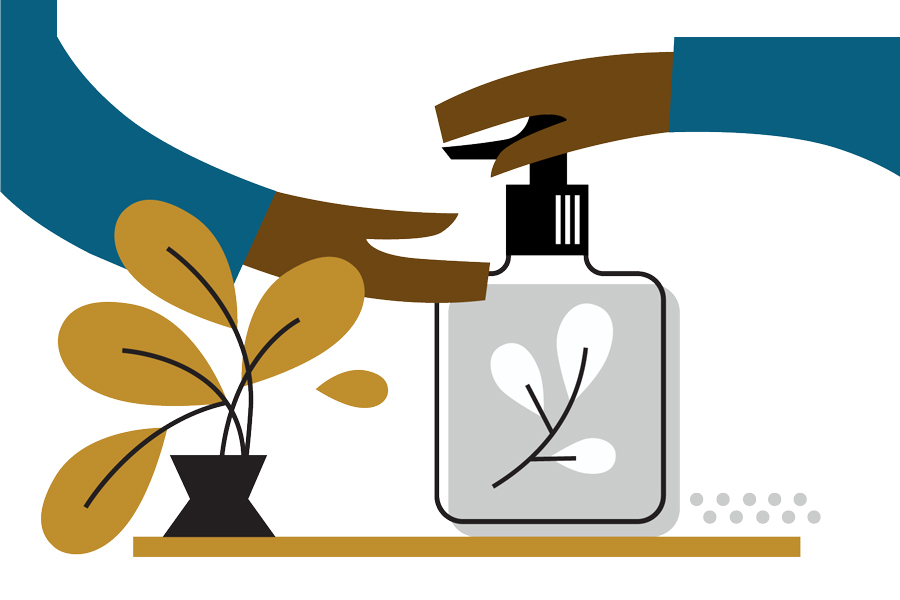
[Updated post from July 15, 2021]
From top department stores to big-box retailers, product sampling has long been a popular in-store activity to boost sales. But in the age of e-commerce, product sampling has evolved into a powerful data-driven strategy to achieve a range of outcomes, from publicizing new product releases to rewarding your most loyal customers.
But product sampling in e-commerce is not as simple as sticking free samples in a package and sending them on their way. If you don't have a strategy in place to guide your sampling campaign, you could end up wasting a lot of time and resources for no gain.
In this guide, we're going to explore how e-commerce brands can set up an effective product sampling campaign that positively shapes customer behavior.
Product sampling refers to the practice of offering customers free samples of merchandise to achieve a certain objective. This could be to boost sales of a specific product, increase customer loyalty, or achieve heightened awareness of your brand.
Traditional product sampling takes place within storefronts, such as grocery stores, big-box stores, and beauty retailers, and is normally designed to bolster consumer confidence ahead of purchase. With the rise of e-commerce, product sampling methods have evolved to take place after a purchase has been made, with free samples added to orders as part of the fulfillment process.
Most of us are familiar with the concept of product sampling in an in-store setting. This typically involves brand ambassadors offering shoppers free product samples to spread the word and increase sales and brand awareness. A sampling station may also be combined with other retail activations, such as pop-up stores, flash sales, or product demonstrations. This is also commonly referred to as direct sampling.
Product sampling in e-commerce requires a very different approach to a retail store, as potential customers are not present in person to speak to brand representatives or try products in real time. For this reason, e-commerce product sampling is often called indirect sampling, as there is no direct interaction between the brand and potential customers.
However, this doesn't have to be a disadvantage. A well-planned product sampling campaign in e-commerce takes advantage of data gathering, greater scalability, and the moment of delivery to craft a compelling narrative that yields a lasting impression of your brand.
No matter whether you're wanting to get customers familiar with new products or spotlight existing products with higher inventory counts, offering samples is a great way to achieve these goals. After all, product sampling is the only marketing strategy in e-commerce that boasts a 100% open rate!
When customers open their order and see free samples thoughtfully added by the brand, the vast majority will respond positively, feeling enticed to try the product out and consider a purchase. Tactile experiences like this in e-commerce are far more effective than a social media ad or email flow, which are easy for consumers to tune out in such a saturated online environment. Taking these experiences offline, businesses make their brand much more memorable.
Many consumers like to stick to what they know when shopping online, especially when shopping for high-ticket items. Even with today's flexible return policies, we would rather avoid the hassle of returning items by making the right purchasing decision in the first place.
This makes ‘try before you buy' strategies like product sampling an invaluable service. Offering free samples in e-commerce means that customers get to try a product from the comfort of their own homes and decide whether or not it fits their needs. For this reason, sample products can play a key role in lowering return rates due to a change of mind or unsuitability.
Surveys show that not only do product samples help boost brand awareness; they're also a source of high conversion rates. According to Peekage, 92% of customers will try product samples when they're on offer, with 53% going on to buy the full-size product later.
Setting up sampling campaigns in-store always involves a bit of guesswork, as it's impossible to know what samples are going to appeal to potential consumers that walk through the door. In e-commerce, you have the benefit of gathering a goldmine of customer data telling you exactly what shoppers are looking for. Every click, wishlist, and purchase helps you to build an in-depth profile that matches the right sample with the right customer, increasing the odds of a future purchase.
Traditional sampling strategies rely on customers wanting to linger around for immersive store experiences, of which there is no guarantee, especially in a post-COVID world. According to Forbes, 79% of consumers say that contactless shopping/browsing methods will continue to be important to them in the future. Moreover, not every shopper will be interested in receiving samples during that particular visit, or won't have the time to engage with brand ambassadors. This makes direct product sampling less predictable than indirect methods, as they cannot be tailored to specific customers.
Digital product sampling campaigns, such as including individually-packaged samples with online customer orders, offer both a safer, contactless alternative and allow customers to interact with their free samples in their own time.
In e-commerce, the moment of delivery is the final impression that brands leave their customers with. If the unboxing experience is memorable and enjoyable, this increases the odds of turning first-time customers into repeat business.
Product samples make a valuable addition to any online order. Free products are a gesture of goodwill that make customers feel appreciated, especially if they have been chosen with the customer's preferences in mind. These sorts of perks - along with attractive packaging and timely shipping - transform an online order from an everyday purchase into a gift-like experience.
One of the biggest advantages of digital product sampling over direct sampling is that e-commerce has a much wider reach and scalability. When included with online orders, product samples can be received by customers globally, whereas brick and mortar stores are limited by their physical location and proximity to customers. Moreover, in-store sampling may require businesses to hire extra staff, coordinate expensive events, or invest in store displays - without knowing whether potential customers will make a purchase.
Because a customer has already placed an order which covers the associated handling, packaging, and shipping fees, adding in a trial-sized sample or free gift is a relatively simple process that requires no significant extra setup. It's even more cost-effective if you have a 3PL on-side who can coordinate product sampling on your behalf (more on this later).
This is the end goal for most brands running product sampling campaigns. However, you can't just send out samples and expect customers to make a purchase; you need to nurture them into making this commitment.
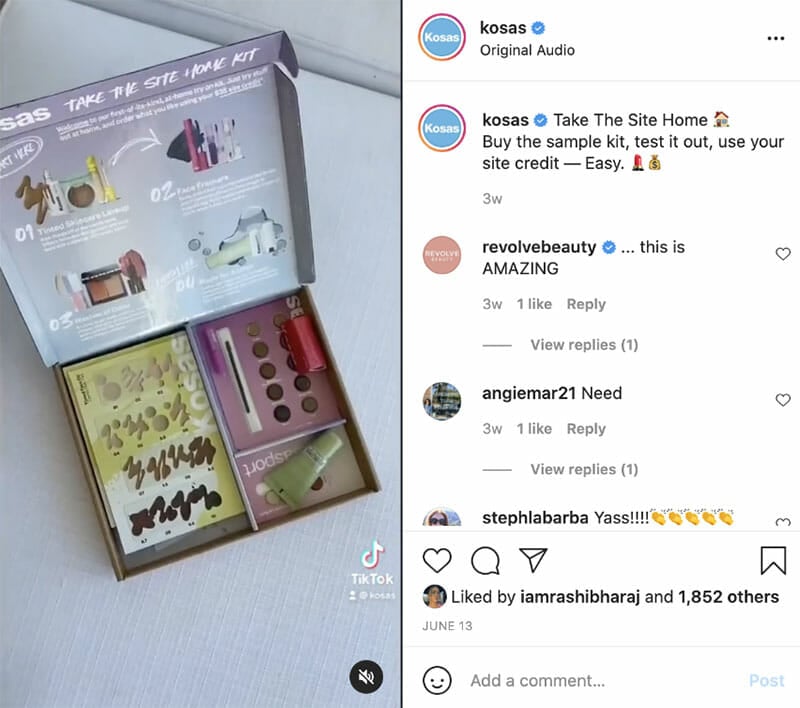
Kosas is one brand that has taken an alternative approach to product sampling. They've curated sampler kits at a price tag of $35, and individual samples at $3-5. Customers can then redeem this as credit on any full-sized item.
Charging for samples might seem like an odd strategy in the world of freebies. But this approach means that customers are testing products they're both financially and emotionally invested in. By offering redeemable credit, Kosa is bringing customers into a longer-term purchasing cycle that's very lucrative for the business.
Product sampling is so attractive to consumers that it's become a business model in its own right. But one brand is a prime example of what happens when e-commerce sampling programs don't make use of robust customer data.
Subscription box service Birchbox was a major success when it first launched in 2010. For a monthly fee of $10, subscribers received five product samples a month across the haircare, skincare, and cosmetics category. When signing up, subscribers fill out a beauty quiz about their skin type, hair type, and product preferences to guide sample selections.
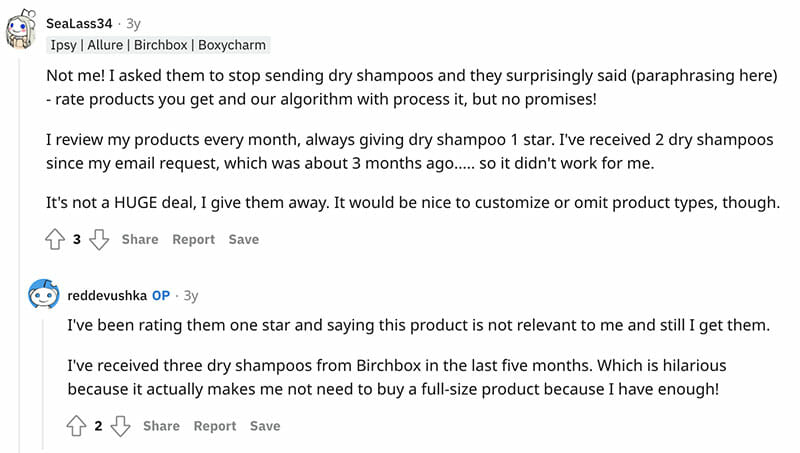
However, this curation process didn't work so well in practice. Reddit threads are full of consumers complaining about receiving the same product multiple times, or products that didn't match the skin tone or hair type they'd selected.
Unless a product sample feels relevant to a customer's needs and tastes, you're giving them the message that your brand knows absolutely nothing about them - and doesn't care to. For this reason, only 32% of consumers say that they try all product samples they receive.
Order histories, browsing data, customer reviews, and loyalty memberships are all fantastic sources of data that help you segment customers based on their shopping and purchasing behaviors. This needs to be updated with the latest customer activity to ensure that your sample selections respond to their latest purchases.
Reviews are the virtual piece of WOM (word of mouth) marketing, as they allow consumers to consult a variety of non-biased sources before committing to a purchase. If one of your products has zero glowing reviews while a competitor's product has hundreds, it's not rocket science which consumers will choose. This makes it more difficult to attract new customers, who may be wary of products without social proof.
While you can elicit reviews from customers buying full-size products, a widespread product sampling campaign is the most effective way of quickly boosting customer reviews for either brand-new products or items that you are trying to shift from your warehouse.

Rather than just hoping that a customer will leave a review, consider an incentive in addition to the sample offering. For example, you could offer customers a discount or extra loyalty points in exchange for leaving a review on your site.
UGC (user-generated content) finds a fertile home on social media for one key reason; people trust what customers say about a product more than the brand. UGC differs from classic influencer marketing; the best UGC comes from everyday customers who are passionate about your brand and want to share this with their community. 79% of people say that UGC highly impacts their purchasing decisions, while only 8% said influencer content would have the same effect.
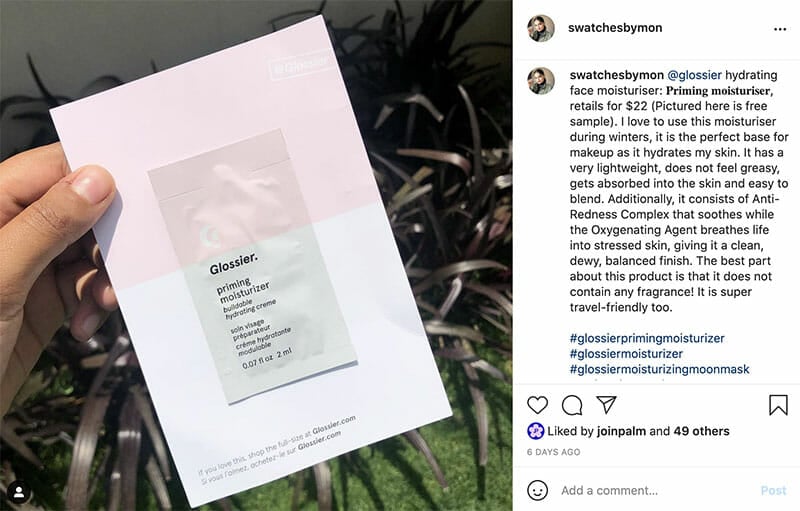
To inspire great UGC content, you need to give customers something exciting to make noise about. An ongoing sampling program ensures that your biggest fans always have something fresh to talk about with your community.
So-called ‘soft launches' of new products are a great way to gauge customer reception and see whether your positioning strategy is working. Product sampling campaigns in particular are well-suited to luxury products that come at a high price point, as customers are less likely to purchase without the chance to test them first. This is why sampling is particularly common within the CPG (Consumer Packaged Goods) category.
When executed well, sampling strategies expose your brand to new audience segments who aren't aware of your offerings – especially if they're presented through a trusted source.

Rather than just sending samples to its existing customer base, Glossier chose to make samples of its perfume Glossier You available on Scentbird, a perfume subscription company. This partnership gives Glossier access to more potential consumers, as well as a powerful e-commerce platform full of helpful reviews and product information.
Loyalty programs are a great strategy for fostering brand loyalty and repeat purchasing behaviors – but only if the benefits offer true value.
Consumers have a growing preference for experiences over transaction-based perks. According to Yotpo, 29% of consumers wish that loyalty rewards on offer were more interesting and varied This is particularly true for the Millennial demographic, where 81% favor loyalty programs that offer a bigger variety of rewards.
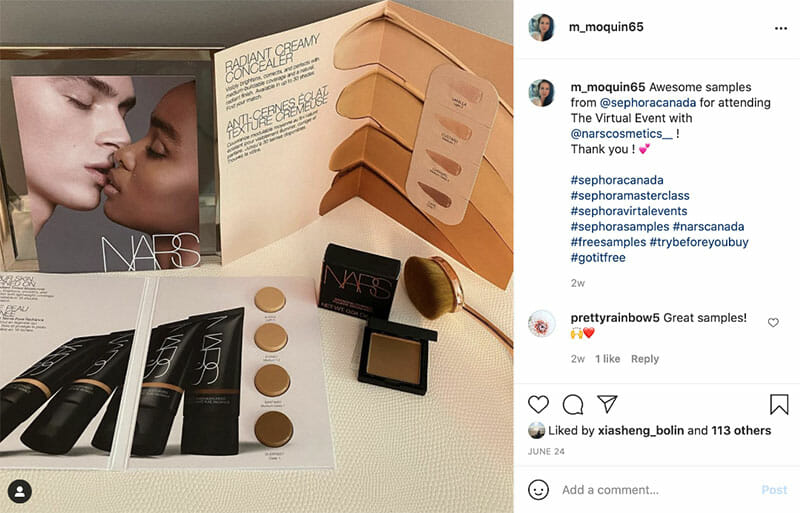
Samples offer your members genuine value, enabling them to experiment with new products from a brand they're already passionate about. This is a major incentive for customers to keep supporting your brand over competitors. Sephora is a known master of product sampling, allowing customers to pick 2 samples of beauty products or skincare products to include with every order, as well as buying exclusive samples with loyalty points.
Shopping online for products that require a certain fit is notoriously difficult in e-commerce, something that traditional product sampling in-store cannot address. Not every customer has the ability to come in-store to try a product, especially if there aren't multiple locations nearby. This causes many customers to turn to bracketing, also known as 'try before you buy'. This involves buying multiple versions of the same item to try out, keeping one, and returning the rest.
Bracketing can cause havoc in e-commerce businesses by distorting inventory levels and increasing return volumes, but it's also understandable from the customer's viewpoint. They don't want to waste time and energy buying the wrong product, and then having to exchange it later.
Implementing a proper 'try before you buy' program in the form of product sampling is a great way to overcome this problem and help customers make informed purchasing decisions. Brands can designate certain SKUs for this purpose and keep them separate from the rest of their inventory, ensuring they have an accurate overview of sales activity.
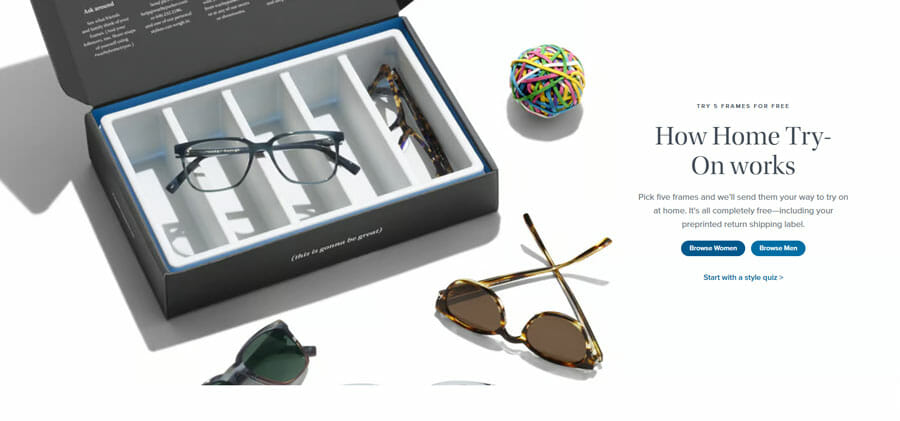
Warby Parker became a huge disruptor in the eyewear space by allowing customers to get five different glasses styles sent to their homes to free before committing to a purchase. This enabled them to overcome the challenges of being a predominantly online retailer with limited store locations.
Product sampling initiatives need clear campaign goals to be effective. These objectives will guide both logistical and marketing considerations, from how many samples you're sending out to the collateral you need to accompany samples.
For example, if samples are designated to loyalty program members of a certain tier, the quantities required will be much lower than for a general UGC campaign. The presentation of product samples may also differ depending on whether they're being included in regular online orders versus a full influencer kit. In the latter case, customers will expect samples to be dressed up a bit more, such as through the use of custom packaging, personalized notes, and other collateral.
Before you start getting attached to highly creative product sampling ideas, it's important to know much money you have to work with. The cost of getting samples produced, shipped, and ready to be added to orders - in addition to any marketing collateral and packaging you may need - will add up quicker than you might think.
The cost of free samples will be dictated by considerations:
Product samples help to increase customer satisfaction and experimentation with new products. But without a call to action, product sampling campaigns are reduced to a random freebie that sparks questions from potential customers like:
If your product sampling campaign is trying to accomplish a specific goal, such as a post-sample purchase, you need to effectively communicate this to your customer using the right collateral. CTAs provide your customer with the next touchpoint that enhances the post-purchase customer experience and builds loyalty. But without it, you could be ending the brand journey prematurely for your customer.
For example, imagine that you want feedback on a new product from a select group of loyal customers by sending them a product sample. You should include an insert that explains that they've been sent this product as a valued customer, along with basic product information and benefits. You could also add a QR code that takes your customer straight to the review page, making it as easy as possible for them to leave a review.
Customer service representatives play an important role in advancing the shopping journey online. After receiving and testing out a product sample, your customer might have questions they can't answer by just checking the product page or reading FAQs.
Your customer service team needs to be prepped with up-to-date product information about your samples so they can answer inquiries quickly. This is particularly important in the case of new product trials that aren't available for purchase on your website. Your responsiveness could be the difference between customers buying from you or choosing to buy from a competitor!
Undertaking regular customer surveys about your product samples is key to knowing whether your strategy is resonating with current and potential customers. You should ask questions such as whether the samples received are of interest to your customers, if they've tested them, and whether they would purchase a full-size of that product.
Surveys like this will give you insight into how product samples are striking a chord with your target audience or if they're creating unintended pain points, such as full-size versions of heavily sampled products being sold out or put on backorder. The more information you have, the easier it is to design a sampling strategy that boosts conversion rates.
Digital product sampling has been invaluable to brands during the pandemic. But foot traffic picking up once again, and integrating product sampling across your selling channels is crucial for a cohesive customer experience.
If a customer knows they get a free sample when shopping online but not in person, they have less incentive to visit a storefront. Omnichannel product sampling also opens up valuable opportunities to shape consumer behavior. For example, if you could make some samples online only and others store-only. This creates a sense of exclusivity and gives your channels distinct value in their own right.
Another option is to gamify the process of earning samples. You could make deluxe product samples available only to those customers who've participated in non-transactional activities, such as referring a friend or joining your email list. This deepens the brand experience and rewards favorable behaviors that benefit your marketing strategy.
If samples are being added to orders, product sampling adds another layer of complexity to the e-commerce fulfillment process, such as:
A full-service fulfillment provider like Ryder enables your brand to coordinate successful product sampling campaigns that boost brand exposure. With state-of-the-art fulfillment locations nationwide and seamless integrations with major e-commerce platforms, Ryder makes it easy to monitor the movement of product samples in real time via our proprietary order management system. With the power of our Order Rules functionality, brands can set custom Packing Rules to add specific free samples to orders with certain characteristics, making it easy to set up a responsive, flexible sampling strategy that works for you.